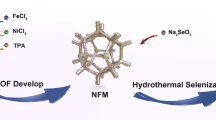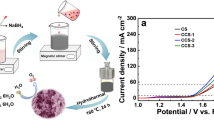Abstract
The development of earth-abundant and highly efficient bifunctional electrocatalysts is a pressing requirement for electrochemical water splitting. However, several critical challenges still need to be addressed. Element doping can effectively enhance the electrocatalytic activity by tuning the microstructure, morphology, and electronic structure. Therefore, this work rationally designs and prepares three-dimensional nanosphere-like structured W-doped CoS1.097/CoSe2 (W-CoS1.097/CoSe2) as efficient bifunctional electrocatalysts for overall water splitting. W-CoS1.097/CoSe2 exhibits super activities with an overpotential of 69.8 mV at −10 mA cm−2 for HER and 400.0 mV at 10 mA cm−2 for OER, respectively. This study provides a new approach for the design of dual-functional catalysts for alkaline water electrolysis of transition metals.






Similar content being viewed by others
Data Availability
Data and materials will be made available on request.
References
Deng C, Toe CY, Li X et al (2022) Earth-abundant metal-based electrocatalysts promoted anodic reaction in hybrid water electrolysis for efficient hydrogen production: recent progress and perspectives. Adv Energy Mater 12(25):2201047
Dong Q, Wang Q, Dai Z et al (2016) Mof-derived Zn-doped CoSe2 as an efficient and stable free-standing catalyst for oxygen evolution reaction. ACS Appl Mater Interfaces 8(40):26902–26907
Huang H-C, Li J, Zhao Y et al (2021) Adsorption energy as a promising single-parameter descriptor for single atom catalysis in the oxygen evolution reaction. J Mater Chem A 9(10):6442–6450
Wu X, Yong C, An X et al (2021) NixCu1-x/CuO/Ni(Oh)2 as highly active and stable electrocatalysts for oxygen evolution reaction. New J Chem 45(39):18482–18490
Dou S, Wang X, Wang S (2019) Rational design of transition metal-based materials for highly efficient electrocatalysis. Small Methods 3(1):1800211
Liang Q, Chen J, Wang F et al (2020) Transition metal-based metal-organic frameworks for oxygen evolution reaction. Coord Chem Rev 424:213488
Zhang K, Zou R (2021) Advanced transition metal-based Oer electrocatalysts: current status, opportunities, and challenges. Small 17(37):2100129
Hu Y, Yang H, Chen J et al (2019) Efficient hydrogen evolution activity and overall water splitting of metallic Co4N nanowires through tunable d-orbitals with ultrafast incorporation of FeOOH. ACS Appl Mater Interfaces 11(5):5152–5158
Zhou H, Zhang D, Dong W et al (2023) Stainless steel mesh-based CoSe/Ni3Se4 heterostructure for efficient electrocatalytic overall water splitting. Int J Hydrog Energy 39:14554–14564
Hanan A, Solangi M, Shah A et al (2023) PdO@CoSe2 composites: efficient electrocatalysts for water oxidation in alkaline media. RSC Adv 13(1):743–755
Rauf M, Yang L, Wang J et al (2023) Correction: manipulation of oxygen evolution reaction kinetics of a free-standing CoSe2-NiSe2 heterostructured electrode by interfacial engineering. Sustain Energy & Fuels 7:904–904
Chen J, Huang F, Ke S et al (2022) A dual-confinement strategy to construct cobalt-based phosphide nanoclusters within carbon nanofibers for bifunctional water splitting electrocatalysts. Dalton Trans 51(13):5168–5174
Lei L, Huang D, Zhang C et al (2020) F dopants triggered active sites in bifunctional cobalt sulfide@nickel foam toward electrocatalytic overall water splitting in neutral and alkaline media: experiments and theoretical calculations. J Catal 385:129–139
Li Y, Hu L, Zheng W et al (2018) Ni/Co-based nanosheet arrays for efficient oxygen evolution reaction. Nano Energy 52:360–368
Xiong T, Yao X, Zhu Z et al (2022) In situ grown Co-based interstitial compounds: Non-3d metal and non-metal dual modulation boosts alkaline and acidic hydrogen electrocatalysis. Small 18(9):2105331
Tan Q, Xiao R, Yao X et al (2022) Non-oxygen anion-regulated in situ cobalt based heterojunctions for active alkaline hydrogen evolution catalysis. Chem Eng J 433:133514
Zhao L, Yang A, Wang A et al (2020) Metallic Co, CoS, and P co-doped N enriched carbon derived from Zif-67 as an efficient catalyst for hydrogen evolution reaction. Int J Hydrog Energy 45(55):30367–30374
Wang J, Wang Y, Yao Z et al (2020) Mo doped amorphous CoSx porous leaf-like nanostructure on Ti mesh as electrocatalyst for alkaline hydrogen production. J Electrochem Soc 167(11):114510
Mosallanezhad A, Wei C, Koudakan PA et al (2022) Interfacial synergies between single-atomic Pt and CoS for enhancing hydrogen evolution reaction catalysis. Appl Catal B Environ 315:121534
Hu L, Wang J, Wang H et al (2023) Gold-promoted electrodeposition of metal sulfides on silicon nanowire photocathodes to enhance solar-driven hydrogen evolution. ACS Appl Mater Interfaces 15(12):15449–15457
Pan Y, Wang M, Li M et al (2022) In-situ construction of N-doped carbon nanosnakes encapsulated FeCoSe nanoparticles as efficient bifunctional electrocatalyst for overall water splitting. J Energy Chem 68:699–708
Chen S, Yang Z, Chen J et al (2022) Electron-rich interface of Cu-Co heterostructure nanoparticle as a cocatalyst for enhancing photocatalytic hydrogen evolution. Chem Eng J 434:134673
Sun X, Habibul N, Du H (2021) Co0.85Se magnetic nanoparticles supported on carbon nanotubes as catalyst for hydrogen evolution reaction. Chin J Catal 42(1):235–243
Wang C, Li Y, Gu C et al (2022) Active Co@CoO core/shell nanowire arrays as efficient electrocatalysts for hydrogen evolution reaction. Chem Eng J 429:132226
Wang H, Jiao S, Liu S et al (2021) Mesoporous bimetallic Au@Rh core-shell nanowires as efficient electrocatalysts for pH-universal hydrogen evolution. ACS Appl Mater Interfaces 13(26):30479–30485
Zhong H, Wang T, Chen Y (2022) Understanding alkaline hydrogen evolution promoted by mesopores in three-dimensional graphene-like materials from perspective of capacitance effects. Carbon 199:13–22
Li F, Wang C, Han X et al (2020) Confinement effect of mesopores: in situ synthesis of cationic tungsten-vacancies for a highly ordered mesoporous tungsten phosphide electrocatalyst. ACS Appl Mater Interfaces 12(20):22741–22750
Tian Z, Guo X, Wang D et al (2020) Enhanced charge carrier lifetime of TiS3 photoanode by introduction of S22- vacancies for efficient photoelectrochemical hydrogen evolution. Adv Funct Mater 30(21):2001286
Yang M, Hu W-H, Li M-X et al (2022) Controlled high-density interface engineering of Fe3O4-FeS nanoarray for efficient hydrogen evolution. J Energy Chem 68:96–103
Li K, Cen X, He JF et al (2023) Coupled W-Co2P hybrid nanosheets as a robust bifunctional electrocatalyst for hydrazine-assisted hydrogen production. Chem Commun 59(37):5575–5578
Guo H, Wu A, Xie Y et al (2021) 2D porous molybdenum nitride/cobalt nitride heterojunction nanosheets with interfacial electron redistribution for effective electrocatalytic overall water splitting. Mater Chem A 9(13):8620–8629
Cheng X, Tong Y (2023) Interface coupling of cobalt hydroxide/molybdenum disulfide heterostructured nanosheet arrays for highly efficient hydrazine-assisted hydrogen generation. ACS Sustain Chem Eng 11(8):3219–3227
Feng D, Ye R, Tong Y et al (2023) Engineering cobalt molybdate nanosheet arrays with phosphorus-modified nickel as heterogeneous electrodes for highly-active energy-saving water splitting. Colloid Interface Sci 636:425–434
Wang Z, Wang P, Zhang H et al (2021) Construction of hierarchical IrTe nanotubes with assembled nanosheets for overall water splitting electrocatalysis. Mater Chem A 9(34):18576–18581
Feng D, Liu XY, Ye R et al (2023) Carbon-encapsulated Co2P/P-modified NiMoO4 hierarchical heterojunction as superior pH-universal electrocatalyst for hydrogen production. Colloid Interface Sci 634:693–702
Yang B, Wei CG, Wang XH et al (2023) Optimization of hydrogen adsorption on W2C by late transition metal doping for efficient hydrogen evolution catalysis. Mater Today Nano 23:100350
Ren Y, Miao X, Zhang J et al (2023) Post cobalt doping and defect engineering of NbSSe for efficient hydrogen evolution reaction. J Mater Chem A 11:2690–2697
Liu T, Zhao X, Liu X et al (2023) Understanding the hydrogen evolution reaction activity of doped single-atom catalysts on two-dimensional Gaps4 by DFT and machine learning. J Energy Chem 81:93–100
Zhou Y, Wu Y, Guo D et al (2023) Sulfur vacancy modulated nickel-doped Co4S3 hollow nanocube/nitrogen-doped V2ctx MXene nanosheet composites for optimizing the hydrogen evolution reaction. Mater Chem Front 7(2):306–314
Tang J, Xu R, Sui G et al (2023) Double-shelled porous g-C3N4 nanotubes modified with amorphous Cu-doped FeOOH nanoclusters as 0D/3D non-homogeneous photo-fenton catalysts for effective removal of organic dyes. Small 22:2208232
Wang C, Wang W, Guo W et al (2023) Liquid nitrogen quenching inducing lattice tensile strain to endow nitrogen/fluorine co-doping Fe3O4 nanocubes assembled on porous carbon with optimizing hydrogen evolution reaction. J Colloid Interface Sci 638:813–824
Bao W, Xiao L, Zhang J et al (2020) Interface engineering of NiV-LDH@FeOOH heterostructures as high-performance electrocatalysts for oxygen evolution reaction in alkaline conditions. Chem Commun 56(65):9360–9363
Zhao G, Jiang Y, Dou S-X et al (2021) Interface engineering of heterostructured electrocatalysts towards efficient alkaline hydrogen electrocatalysis. Sci Bull 66(1):85–96
Yang X, Wang Y, Yang X et al (2023) Lattice strain assisted with interface engineering for designing efficient CoSe2-CoO core-shell microspheres as promising electrocatalysts towards overall water splitting. Colloids Surf A Physicochem Eng Asp 663:131039
Yu T, Xu Q, Luo L et al (2022) Interface engineering of NiO/RuO2 heterojunction nano-sheets for robust overall water splitting at large current density. Chem Eng J 430:133117
Wu J, Wang X, Jiang J et al (2021) In-situ synthesis of MoS2/Co9S8 heterostructure for efficient HER electrocatalyst. Mater Lett 292:129621
Chen R, Yao J, Gu Q et al (2013) A two-dimensional zeolitic imidazolate framework with a cushion-shaped cavity for Co2 adsorption. Chem Commun 49(82):9500–9502
Guan C, Xiao W, Wu H et al (2018) Hollow Mo-doped CoP nanoarrays for efficient overall water splitting. Nano Energy 48:73–80
Ahmad YH, Mohamed AT, Alashraf A et al (2020) Highly porous PtPd nanoclusters synthesized via selective chemical etching as efficient catalyst for ethanol electro-oxidation. Appl Surf Sci 508:145222
Xu H, Shang H, Wang C et al (2020) Surface and interface engineering of noble-metal-free electrocatalysts for efficient overall water splitting. Coord Chem Rev 418:213374
Hang Z, Wang H, Ma M et al (2021) Integrating NiMoO wafer as a heterogeneous ‘turbo’for engineering robust Ru-based electrocatalyst for overall water splitting. Chem Eng J 420:127686
Huang J, Jiang Y, An T et al (2020) Increasing the active sites and intrinsic activity of transition metal chalcogenide electrocatalysts for enhanced water splitting. J Mater Chem A 8(48):25465–25498
Zheng Y, Rong J, Xu J et al (2021) Accessible active sites activated by cobalt-doping into MoS2/NiS2 nanosheet array electrocatalyst for enhanced hydrogen evolution reaction. Appl Surf Sci 563:150385
Wang J, Hu H, Zhang H et al (2021) Regulating the catalytically active sites in low-cost and earth-abundant 3d transition-metal-based electrode materials for high-performance zinc-air batteries. Energy Fuel 35(8):6483–6503
Sun J, Huang Z, Huang T et al (2019) Defect-rich porous CoS1. 097/MoS2 hybrid microspheres as electrocatalysts for pH-universal hydrogen evolution. ACS Appl Energy Mater 2(10):7504–7511
Xia Q, Zhao L, Zhang Z et al (2021) MnCo2S4-CoS1.097 heterostructure nanotubes as high efficiency cathode catalysts for stable and long-life lithium-oxygen batteries under high current conditions. Adv Sci 8(22):2103302
Li Y, Mao Z, Wang Q et al (2020) Hollow nanosheet array of phosphorus-anion-decorated cobalt disulfide as an efficient electrocatalyst for overall water splitting. Chem Eng J 390:124556
Singh B, Murad L, Laffir F et al (2011) Pt based nanocomposites (mono/bi/tri-metallic) decorated using different carbon supports for methanol electro-oxidation in acidic and basic media. Nanoscale 3(8):3334–3349
Zhang H, Mei H, Qin D et al (2021) Conversion of amorphous MOF microspheres into a nickel phosphate battery-type electrode using the “anticollapse” two-step strategy. Inorg Chem 60(22):17094–17102
Tong H, Chen S, Yang P et al (2021) Cage-confinement pyrolysis strategy to synthesize hollow carbon nanocage-coated copper phosphide for stable and high-capacity potassium-ion storage. ACS Appl Mater Interfaces 13(44):52697–52705
Funding
This work was supported by the NSF of China (22205125).
Author information
Authors and Affiliations
Contributions
Dongxuan Guo, Jinlong Li, and Dawei Chu planned the study and guided the whole project. Guozhe Sui organized the data and draw the figures. Muran Yu, Shengnan Na, and Daqing Li performed the experimental measurement of samples. Xiuna Yang performed the data analysis and wrote the manuscript.
Corresponding authors
Ethics declarations
Ethical approval
Not applicable.
Competing interests
The authors declare no competing interests.
Additional information
Publisher’s note
Springer Nature remains neutral with regard to jurisdictional claims in published maps and institutional affiliations.
Supplementary information
ESM 1
(DOCX 1008 kb)
Rights and permissions
Springer Nature or its licensor (e.g. a society or other partner) holds exclusive rights to this article under a publishing agreement with the author(s) or other rightsholder(s); author self-archiving of the accepted manuscript version of this article is solely governed by the terms of such publishing agreement and applicable law.
About this article
Cite this article
Yang, X., Sui, G., Guo, D. et al. Tungsten-doped cobalt sulfide/selendie as high-efficient electrocatalyst for outstanding overall water splitting. Ionics 29, 4115–4123 (2023). https://doi.org/10.1007/s11581-023-05128-2
Received:
Revised:
Accepted:
Published:
Issue Date:
DOI: https://doi.org/10.1007/s11581-023-05128-2




